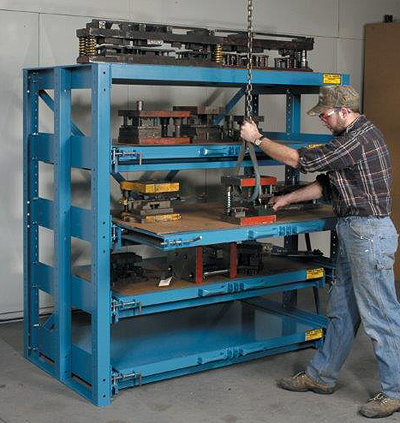Roll-Out & Crank-Out Shelf Racks
Improve workflow with easier access to heavy loads
Get Quote
Store very heavy, concentrated loads efficiently and safely
Roll-out shelf racks have high capacities capable of supporting items like motors, dies, and heavy parts. They also help smooth processes by allowing you to store and access parts and tools near work cells where they are needed.
The racks are rugged enough for forklift loading and unloading, but one of the safety benefits of the extending shelves is that they allow gentle, ergonomic handling of loads with overhead equipment such as cranes, hoists, and monorails, so you can keep forklifts out of work areas. Precise placement with lifting devices also helps prevent damage to expensive components.
Crank-out shelves vs. gliding shelves
Crank-out shelf racks have very high capacities— up to 5,000 pounds per shelf. Shelves extend 75% of their depth out of the rack frame and operate with a crank handle that you manually rotate.
To open a gliding shelf, simply pull on the shelf you need to access. There are locking mechanisms that prevent the shelves from accidentally opening when not in use. Shelves have 100% extension, meaning you can access the full depth of the shelf with overhead handling methods. However, their top capacities are a bit lower than crank-out shelves at up to 3,000 pounds per shelf.
Rack Engineering vs. Meco & Jarke roll-out shelves
Rack Engineering has a wide range of standard sizes and capacities that can handle 1,000, 2,000, or 3,000 pounds per shelf. Meco and Jarke gliding shelves have a standard capacity of 2,000 pounds per shelf.






